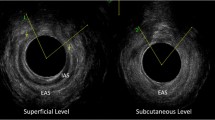Abstract
Introduction and hypothesis
Our purpose was to establish the incidence of anal and urinary incontinence 4 years following vaginal delivery in women with and without obstetric anal sphincter injuries (OASIS).
Methods
This was a prospective study of 241 having their first vaginal delivery who had independent verification and repair of OASIS by trained obstetricians. All obstetricians performing OASIS repairs had undergone structured hands-on training and were then directly supervised while repairing OASIS until they were deemed competent to repair independently. Patients were followed up for 4 years with validated bowel and urinary questionnaires. In order to minimise nonresponders, contact details were verified and obtained from their general practitioners, the local primary care trust and electoral roll.
Results
Two hundred and fifty-four women were invited, and 241 (95 %) participated. Fifty-nine (25 %) women sustained OASIS. One hundred and forty-nine were contactable 4 years later, and 86 (58 %) agreed to participate in the study at 4 years. No woman had faecal incontinence, and there was no difference in rates of flatus incontinence prior to delivery up to 4 years postpartum, regardless of whether OASIS occurred or not. Urinary incontinence was more than four times more common after vaginal birth, and this was not affected by whether OASIS occurred and resulted in a significant deterioration in quality of life.
Conclusions
The previously reported higher rates of anal incontinence following OASIS can be minimised up to 4 years after delivery if repaired by trained doctors. There is a significant increase in urinary incontinence following vaginal delivery, and the mechanism for this is not linked to anal sphincter disruption.

Similar content being viewed by others
References
Scheer I, Andrews V, Thakar R, Sultan AH (2008) Urinary incontinence after Obstetric Anal Sphincter Injuries (OASIS) - Is there a relationship? Int Urogynecol J Pelvic Floor Dysfunct 19:179–183
Viktrup L (2002) The risk of lower urinary tract sypmptoms five years after the first delivery. Neurourol Urodyn 21(1):2–29
Fernando R, Sultan AH, Radley S, Jones PW, Johanson RB (2002) Management of obstetric anal sphincter injury: a systematic review and national practice survey. BMC Health Serv Res 2:9
Wagenius J, Laurin J (2003) Clinical symptoms after anal sphincter rupture: a retrospective study. Acta Obstet Gynecol Scand 82:246–250
Johanson JF, Lafferty J (1996) Epidemiology of fecal incontinence: the silent affliction. Am J Gastroenterol 91:33–36
Hagglund D, Wadensten B (2007) Fear of humiliation inhibits women’s care-seeking behaviour for long-term urinary incontinence. Scand J Caring Sci 21:305–312
Bugg GJ, Kiff ES, Hosker G (2001) A new condition-specific health-related quality of life questionnaire for the assessment of women with anal incontinence. Br J Obstet Gynecol 108:1057–1067
Avery K, Donovan JL, Abrams P (2001) Validation of a new questionnaire for incontinence: the international consultation on incontinence questionnaire (ICI-Q). Neurourol Urodyn 20:86
Royal College of Obstetricians and Gynaecologists (2007) Third- and fourth-degree perineal tears - management. RCOG Press, London, RCOG Guideline No. 29
Andrews V, Thakar R, Sultan AH (2009) Structured hands-on training in repair of obstetric anal sphincter injuries (OASIS): an audit of clinical practice. Int Urogynaecol J 20:193–199
Thakar R, Sultan AH (2003) Management of obstetric anal sphincter injury. Obstet Gynaecol 5(2):72–78
Andrews V, Sultan AH, Thakar R, Jones PW (2006) Occult anal sphincter injuries – myth or reality. Br J Obstet Gynecol 113:195–200
Sander P, Bjarnesen J, Mouritsen L, Fuglsang-Frederiksen A (1999) Anal incontinence after obstetric third-/fourth-degree laceration. One-year follow-up after pelvic floor exercises. Int Urogynecol J 10:177–181
Pinta TM, Kylanpaa ML, Salmi TK et al (2004) Sphincter rupture and anal incontinence after first delivery. Acta Obstet Gynecol Scand 83:917–922
Fitzpatrick M, Cassidy M, O’Connell R, O’Herlihy C (2002) Experience with an obstetric perineal clinic. Eur Jour Obstet Gynecol Reprod Biol 100:199–203
Starck M, Bohe M, Valentin L (2006) The extent of endosonographic anal sphincter defects after primary repair of obstetric sphincter tears increases over time and is related to anal incontinence. Ultrasound Obstet Gynecol 27:188–197
Zetterstrom J, Lopez A, Anzen B, Norman M, Holmstrom B, Mellgren A (1999) Anal sphincter tears at vaginal delivery: risk factors and clinical outcome of primary repair. Obstet Gynecol 94(1):21–28
Uustal Fornell EK, Berg G, Hallbook O, Matthiesen LS, Sjodahl R (1996) Clinical consequences of anal sphincter rupture during childbirth. J Am Coll Surg 183:553–558
Nazir M, Stein R, Carlsen E et al (2003) Early evaluation of bowel symptoms after primary repair of obstetric perineal rupture misleading. Dis Colon Rectum 46(9):1245–1250
Tetzschner T, Sorensen M, Ge L et al (1996) Anal and urinary incontinence in women with obstetric anal sphincter rupture. Br J Obstet Gynecol 103:1034–1040
Otero M, Boulvain M, Bianchi-Demicheli F et al (2006) Women’s health 18 years after rupture of the anal sphincter during childbirth. Urinary incontinence, sexual function, and physical and mental health. Am J Obstet Gynecol 194(5):1260–1265
Borello-France D, Burgio KL, Richter HE et al (2006) Fecal and urinary incontinence in primiparous women. Obstet Gynecol 108:863–872
Sultan AH, Kamm MA, Hudson CN, Thomas JM, Bartram CI (1993) Anal sphincter disruption during vaginal delivery. New Eng J Med 329:1905–1911
Conflicts of interest
None.
Author information
Authors and Affiliations
Corresponding author
Rights and permissions
About this article
Cite this article
Andrews, V., Shelmeridine, S., Sultan, A.H. et al. Anal and urinary incontinence 4 years after a vaginal delivery. Int Urogynecol J 24, 55–60 (2013). https://doi.org/10.1007/s00192-012-1835-7
Received:
Accepted:
Published:
Issue Date:
DOI: https://doi.org/10.1007/s00192-012-1835-7




